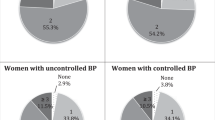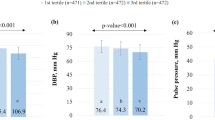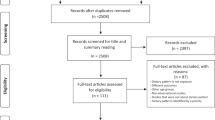Abstract
The impact of dietary and lifestyle factors on the prevalence of hypertension was quantified for Finland, Italy, The Netherlands, UK and USA. For this purpose, we combined data of blood pressure (BP) and risk factors distributions in these five countries with BP estimates from randomized controlled trials of dietary and lifestyle factors to obtain population attributable risk percentages (PAR%) for hypertension. Overweight made a substantial contribution to hypertension (PAR%: 11–17%), as was the case for excessive sodium intake (9–17%), low potassium intake (4–17%), physical inactivity (5–13%), and low intake of fish oil (3–16%). PAR% were smaller for low calcium intake (2–8%), low magnesium intake (4–8%), excessive coffee consumption (1–9%) and excessive alcohol intake (2–3%). We conclude that diet and lifestyle have a major impact on hypertension in Western societies. The relative significance of different risk factors varies among populations, which is important for preventive strategies.
This is a preview of subscription content, access via your institution
Access options
Subscribe to this journal
Receive 12 digital issues and online access to articles
$119.00 per year
only $9.92 per issue
Buy this article
- Purchase on Springer Link
- Instant access to full article PDF
Prices may be subject to local taxes which are calculated during checkout
Similar content being viewed by others
References
Jekel JF, Elmore JG, Katz DL (eds). Assessment of risk in epidemiologic studies. In: Epidemiology, Biostatistics, and Preventive Medicine, 2nd edn. WB Saunders Company: Philadelphia, 1996, pp 74–82.
Geleijnse JM et al. Blood pressure response to fish oil supplementation: metaregression analysis of randomized trials. J Hypertens 2002; 20: 1493–1499.
Geleijnse JM, Kok FJ, Grobbee DE . Blood pressure response to changes in sodium and potassium intake: a meta-regression analysis of randomised trials. J Hum Hypertens 2003; 17: 471–480.
Neter JE et al. Influence of weight reduction on blood pressure: a meta-analysis of randomized controlled trials. Hypertension 2003; 42: 878–884.
Geleijnse JM, Grobbee DE, Kok FJ . Impact of dietary and lifestyle factors on the prevalence of hypertension in Western populations. Eur J Public Health 2004; 14: 235–239.
Kuulasmaa K, Hense HW, Tolonen H, for the WHO MONICA Project. Quality assessment of data on blood pressure in the WHO MONICA project, 1998. [http://www.ktl.fi/publications/monica/bp/table8.htm; last accessed October 2, 2005].
U.S. Department of Health and Human Services (DHHS). National Center for Health Statistics. Third National Health and Nutrition Examination Survey, 1988–1994, NHANES III Examination Data File and Total Nutrient Intake File. Hyattsville, MD: Centers for Disease Control and Prevention, 1996. Public use data files, available from National Technical Information Service (NTIS), Springfield, VA. [http://www.cdc.gov/nchs/about/major/nhanes/nh3data.htm; last accessed October 2, 2005].
Elliott P, Dyer A, Stamler R . The INTERSALT study: results for 24 h sodium and potassium, by age and sex. INTERSALT Co-operative Research Group. J Hum Hypertens 1989; 3: 323–407.
McClelland GH Stanford University, Dept of Statistics Seeing Statistics, ©Duxbury Press: Stanford, CA, USA, 1999 [http://psych.colorado.edu/~mcclella/java/normal/accurateNormal.html; last accessed October 2, 2005].
Psaty BM et al. Association between blood pressure level and the risk of myocardial infarction, stroke, and total mortality: the cardiovascular health study. Arch Intern Med 2001; 161: 1183–1192.
Stamler J, Stamler R, Neaton JD . Blood presure, systolic and diastolic, and cardiovascular risks. US population data. Arch Intern Med 1993; 153: 598–615.
Kungel OH et al. Estimating the prevalence of hypertension corrected for the effect of within-person variability in blood pressure. J Clin Epidemiol 2000; 53: 1158–1163.
Ferraroni M et al. Reproducibility and validity of coffee and tea consumption in Italy. Eur J Clin Nutr 2004; 58: 674–680.
Tavani A, Negri E, La Vecchia C . Coffee intake and risk of hip fracture in women in northern Italy. Prev Med 1995; 24: 396–400.
Tavani A et al. Risk factors for non-fatal acute myocardial infarction in Italian women. Prev Med 2004; 39: 128–134.
Acknowledgements
This work was commissioned by the Factors Affecting Hypertension Task Force of the European branch of the International Life Sciences Institute (ILSI Europe). At the time of the workshop, industry members of this task force were Frito Lay, Kellog, RHM Technology, Unilever and Valio. Further information about ILSI Europe can be obtained through info@ilsieurope.be or tel. +32 (0) 2 771 0014.
Author information
Authors and Affiliations
Corresponding author
Additional information
The full version of this paper has previously been published in European Journal of Public Health 2004;14:235-9.
Rights and permissions
About this article
Cite this article
Geleijnse, J., Grobbee, D. & Kok, F. Impact of dietary and lifestyle factors on the prevalence of hypertension in Western populations. J Hum Hypertens 19 (Suppl 3), S1–S4 (2005). https://doi.org/10.1038/sj.jhh.1001953
Published:
Issue Date:
DOI: https://doi.org/10.1038/sj.jhh.1001953
Keywords
This article is cited by
-
Predicting surgical outcomes for chronic exertional compartment syndrome using a machine learning framework with embedded trust by interrogation strategies
Scientific Reports (2021)
-
Exploratory study of the association in the United Kingdom between hypertension and inorganic arsenic (iAs) intake from rice and rice products
Environmental Geochemistry and Health (2021)
-
The effect of acute vs chronic magnesium supplementation on exercise and recovery on resistance exercise, blood pressure and total peripheral resistance on normotensive adults
Journal of the International Society of Sports Nutrition (2015)
-
Dietary mineral intakes of rural midlife to older adult women with prehypertension in Midwestern United States
The Journal of nutrition, health and aging (2015)
-
Dietary patterns and hypertension among Chinese adults: a nationally representative cross-sectional study
BMC Public Health (2011)



